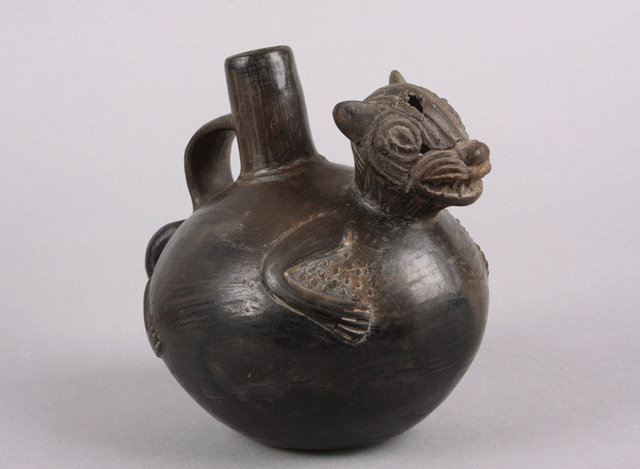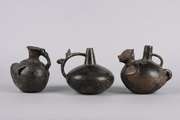
Guest Curator: Dragana Damljanović*
Photograph by B. Bernard
This collection of Chimú stirrup spout vessels and handled
pitchers was donated between 1937 and 1992, by eight different collectors.
Not one of the ceramic pieces has a provenience. Likewise, there is no
direct record of the age of the objects. The term "Chimú style,"
found in the museum's accession records, was the point of departure for
the original exhibit and this online focus.
The term "Chimú" refers to a rather general art style of the Chimor Kingdom, created on the north coast of Peru between A.D. 900 and 1532. The style is loosely defined because it includes a great deal of regional and local variation.
The earlier Moche tradition, which developed in the same territory, had the greatest artistic influence on Chimú. Moche elements in Chimú pottery include small modeled figures (such as monkeys on the spouts of stirrup spout bottles) and marine elements (such as crabs and Spondylus shells. Tbe interplay between the memories of Moche iconography and the fertility of the Chimú style was an immensely creative one.
The Chimor Kingdom was well organized, with a clear hierarchy. The great city of Chan Chan, in the Moche Valley, was the capital of the kingdom. The powerful visual rhetoric created by Chimor should be seen in terms of the need to find symbols around which to define the unity of the kingdom (for example, certain motifs appeared on the ruler's tunics as well as on ceramics.
An appreciation of the value of visual propaganda, including the repeated use of a variety of abstract symbols to enhance the kingdom's image, is the context within which the exhibited vessels were made. The conscious creation of distinctive symbols is the primary reason we are able to tell Chimú style from contemporary stylistic movements.
With the destruction of the Chimor kingdom at the hands of the Incas in A.D. 1470, Chim´ style began to wither.
Mold-making was used in ancient Peru, particularly by the Moche and the subsequent Chimú potters. Molds were made from fired clay that had been formed over an existing object by pressing clay around the chamber of a stirrup-spout vessel, cutting the clay in two, and then removing the two halves. Two-piece molds were the type most frequently used.
To make the pot, clay was pressed into the mold. As the clay dried it shrank away from the mold. Once removed, the two sections of a pot were joined and a "wash" (thin clay slurry) would be applied. The seam left along the join was removed by smoothing. If a pot or portion of a pot was too complicated to be made in a two-piece mold, it could be made in sections that were then joined. The stirrup spout section could be created this way, as you will see if you click here. The spout could instead be made along with the rest of the vessel, using the two-part mold, as is shown here.
(Each of the following selections is based on one of the display cases in the original exhibit.)
 Abstraction and mass production
Abstraction and mass production
*This special focus is modified from a Maxwell Museum exhibit created by Dragana Damljanović, then an MA candidate in art history at UNM. The exhibit opened in May 2006 and closed in February 2011.
Copyright © Maxwell Museum of Anthropology, University of New Mexico. A high-resolution verson of any photograph may be ordered from the Maxwell Museum's photo archives. Please make note of the catalogue number. For more information please visit the photo archives web page
Page last revised on March 28, 2011. Please report problems to toh@unm.edu